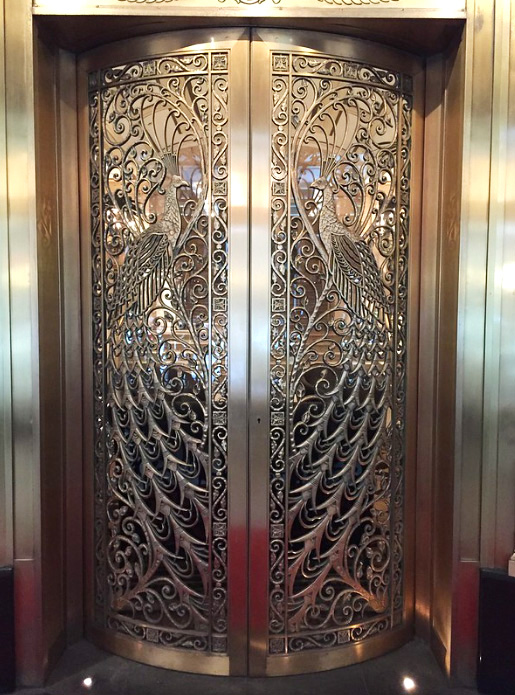
In 1743, King Louis XV had a so-called, “flying chair” that connected his apartments with his favorite mistress. By 1895 The Biltmore Estate had installed an elevator. Hotels began to install them for their rich customers’ comfort. Following the Great Chicago Fire of 1871, new Tiffany & Co. art deco bronze peacock doors were installed at the Palmer House Hotel in 1873.

Lifting loads by mechanical means, an elevator, called a lift in some locales, is first mentioned in the 1st Century, B.C., by Vitruvius. He described a lifting platform of used pulleys, capstones, or windlasses which were operated by human, animal or water power. Steam power was applied to such devices in England by 1800. An American, Elisha Groves Otis, designed a safety device in 1853 which made the passenger elevator possible. Otis’ device was demonstrated at the Crystal Palace Exposition in New York in 1851. The first passenger elevator began service in the Haughwout Department Store in New York City in 1857. It was driven by steam power and climbed five stories in less than a minute. Express installations for the upper levels of the Empire State Building in 1931 reached 1,800 feet per minute.
Situated in the Reliance Building at 1 W. Washington and State Street, Chicago, is the Burnham Hotel and Café Atwood. The eye takes in the red marble walls and terrazzo floors, the blooming white orchids, the art deco lamps and rugs, and the dark mahogany woods. The stunning elevators are a grand design of art deco beauty. These elevators almost look majestic with the filigreed grills and swirls and gilted-designs!
The Reliance Building, designed by Charles B. Atwood of D.H. Burnham & Co., was completed in 1895. It was one of the world’s earliest skyscrapers rising an impressive 14 floors above State Street, a glass and terra cotta beauty built with a steel frame that seemed to defy gravity. The building was designated a National Historic Landmark in 1970, a City of Chicago landmark in 1975 and a State of Illinois landmark in 1979. The Hotel offers the guest a special pillow menu, a rest on Italian bed linens, and a complete non-smoking facility.
Another elevator of note are those in the Eiffel Tower in Paris. There are custom-built lifts that carry visitors to and from the first and second levels of the Eiffel Tower. The elevators are constructed to move upwards and downwards at two different angels in order to match the angles of the Tower’s legs. There are elevators in all four legs of the tower. Three legs have elevators that carry ordinary visitors.
The southern pillar elevator has a tiny private elevator that takes passengers directly to and from the fancy Jules Verne restaurant on the second level of the towers. There is a stairway to or from the first or second levels of the tower. The summit only can be reached by elevator, however.
A third elevator of note is governed by the National Park Service. Completed in 1965, the St. Louis Gateway Arch has attracted millions of visitors. It is on the west bank of the Mississippi River where the City was founded. The arch was designed by Finnish American architect Eero Saarinen and structural engineer, Hannskarl Bandel, in 1947. Construction began February 12, 1963 at the cost of $13 million dollars to complete by 1965. (That sum would be more than $90 million in today’s dollars.) The arch has two sets of stairs with 1,076 steps each. The elevators/trams are built on a diagonal angle up to the 633-foot height of the arch. The ascent in the elevators is rapid within a very confined space.
- The July 20 edition headline should have read: Jeanne d’ Arc military heroine of France dies at age 19

